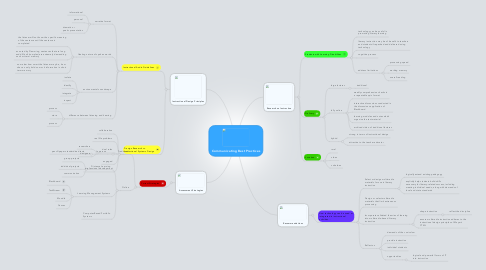
1. Instructional Design Principles
1.1. Instructional Audio Guidelines
1.1.1. narrative format
1.1.1.1. informational
1.1.1.2. personal
1.1.1.3. dramatic or poetic presentation
1.1.2. fleeting nature of spoken words
1.1.2.1. the listener will not know the specific meaning of the sentence until the sentence is completed
1.1.2.2. as noted by Flemming, sentences that are long and difficult (complex) are extremely demanding on short term memory
1.1.2.3. no matter how smart the listener may be, he or she can only hold so much information in short term memory
1.1.3. environmental soundscape
1.1.3.1. isolate
1.1.3.2. identify
1.1.3.3. integrate
1.1.3.4. inspect
1.1.4. difference between listening and hearing
1.1.4.1. process
1.1.4.2. store
1.1.4.3. process
1.2. Design Research vs. Instructional Systems Design
1.2.1. collaboration
1.2.2. real life problems
1.2.3. dual roles
1.2.3.1. researchers
1.2.3.2. designers
1.2.4. engaged
1.2.5. professional development
2. Assessment Strategies
2.1. Current Strategies
2.1.1. Traditional
2.1.1.1. In person
2.1.1.1.1. pencil/paper standardized tests
2.1.2. Online
2.1.2.1. Distance Learning
2.1.2.1.1. group projects
2.1.2.1.2. individual projects
2.1.2.1.3. communication
2.1.2.2. Learning Management Systems
2.1.2.2.1. Blackboard
2.1.2.2.2. TaskStream
2.1.2.2.3. Moodle
2.1.2.2.4. Canvas
2.1.2.3. Computer-Based Portfolio Systems
3. Research on Instruction
3.1. Students with Learning Disabilities
3.1.1. technology can be useful in promoting literacy learning
3.1.2. literacy instruction may be of benefit to teachers and students if repacked and delivered using technology
3.1.3. cognitive process
3.1.4. address limitations
3.1.4.1. processing speed
3.1.4.2. working memory
3.1.4.3. overall reading
3.2. Delivery
3.2.1. large lectures
3.2.1.1. traditional
3.2.2. fully online
3.2.2.1. weekly comprehension checks in a repeatable quiz format
3.2.2.2. interactive discussions conducted in the discussions application of Blackboard
3.2.2.3. learning modules and notes which organize the text material
3.2.2.4. archived video of traditional lectures
3.2.3. hybrid
3.2.3.1. strong in terms of instructional design
3.2.3.2. attractive to the teacher educator
3.3. Location
3.3.1. rural
3.3.2. urban
3.3.3. suburban
4. Recommendations
4.1. How technology can be used or integrated in instructional activities...
4.1.1. Select or design multimedia materials for use in literacy instruction
4.1.1.1. logically extend existing pedagogy
4.1.1.2. explicitly help students build skills necessary for literacy-related success, including meeting individual needs, along with demands of local and state standards
4.1.2. Design or select multimedia materials that limit extraneous processing
4.1.3. Incorporate validated theories of learning into multimedia-based literacy instruction
4.1.3.1. shape instruction
4.1.3.1.1. reflect the discipline
4.1.3.2. ensure multimedia instruction adheres to the instructional design principles of Mayer's CTML
4.1.4. Reflect on
4.1.4.1. demands of the curriculum
4.1.4.2. provide instruction
4.1.4.3. individual students
4.1.4.4. opportunities
4.1.4.4.1. logical and powerful forms of IT into instruction
